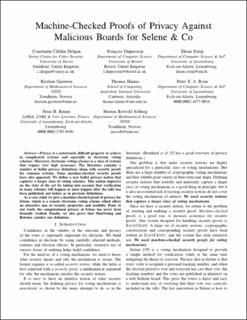| dc.contributor.author | Drăgan, Constantin Cătălin | |
| dc.contributor.author | Dupressoir, François | |
| dc.contributor.author | Estaji, Ehsan | |
| dc.contributor.author | Gjøsteen, Kristian | |
| dc.contributor.author | Haines, Thomas | |
| dc.contributor.author | Ryan, Peter Y. A. | |
| dc.contributor.author | Rønne, Peter B. | |
| dc.contributor.author | Solberg, Morten Rotvold | |
| dc.date.accessioned | 2022-12-08T10:10:12Z | |
| dc.date.available | 2022-12-08T10:10:12Z | |
| dc.date.created | 2022-11-03T10:48:47Z | |
| dc.date.issued | 2022 | |
| dc.identifier.isbn | 978-1-6654-8417-6 | |
| dc.identifier.uri | https://hdl.handle.net/11250/3036708 | |
| dc.description.abstract | Privacy is a notoriously difficult property to achieve in complicated systems and especially in electronic voting schemes. Moreover, electronic voting schemes is a class of systems that require very high assurance. The literature contains a number of ballot privacy definitions along with security proofs for common systems. Some machine-checked security proofs have also appeared. We define a new ballot privacy notion that captures a larger class of voting schemes. This notion improves on the state of the art by taking into account that verification in many schemes will happen or must happen after the tally has been published, not before as in previous definitions. As a case study we give a machine-checked proof of privacy for Selene, which is a remote electronic voting scheme which offers an attractive mix of security properties and usability. Prior to our work, the computational privacy of Selene has never been formally verified. Finally, we also prove that MiniVoting and Belenios satisfies our definition. | en_US |
| dc.language.iso | eng | en_US |
| dc.publisher | IEEE | en_US |
| dc.relation.ispartof | 2022 IEEE 35th Computer Security Foundations Symposium (CSF) | |
| dc.title | Machine-Checked Proofs of Privacy Against Malicious Boards for Selene & Co | en_US |
| dc.title.alternative | Machine-Checked Proofs of Privacy Against Malicious Boards for Selene & Co | en_US |
| dc.type | Chapter | en_US |
| dc.description.version | acceptedVersion | en_US |
| dc.rights.holder | © IEEE. Personal use of this material is permitted. Permission from IEEE must be obtained for all other uses, in any current or future media, including reprinting/republishing this material for advertising or promotional purposes, creating new collective works, for resale or redistribution to servers or lists, or reuse of any copyrighted component of this work in other works. | en_US |
| dc.source.pagenumber | 319-331 | en_US |
| dc.identifier.cristin | 2068501 | |
| dc.relation.project | Norges forskningsråd: 275516 | en_US |
| cristin.ispublished | true | |
| cristin.fulltext | postprint | |
| cristin.qualitycode | 1 | |
